Shuttle Discovery hauled to launch pad for final flight (UPDATED)
Editor's note...
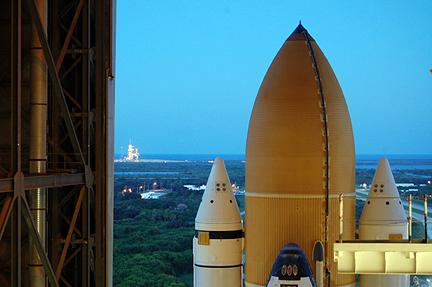
With launch pad 39A waiting in the distance, the shuttle Discovery
leaves the Vehicle Assembly Building for the last time.
The shuttle Discovery, mounted atop a mobile launch platform carried by an Apollo-era crawler transporter, was hauled to the launch pad overnight Monday for work to ready the ship for blastoff Nov. 1 on its 39th and final flight.
The 3.2-mile trip from the Vehicle Assembly Building to launch complex 39A began at 7:23 p.m. EDT and was completed at 1:49 a.m. Tuesday when the mobile launch platform was reported "hard down" on its support pedestals at the oceanside pad. With good weather expected, a protective gantry will be left parked away from the vehicle to give Kennedy Space Center workers a chance to visit the pad and enjoy an unobstructed view of NASA's most experienced orbiter.
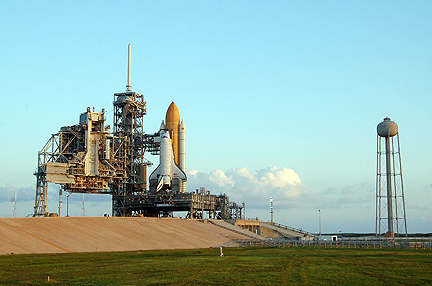
Space shuttle Discovery mounted atop pad 39A.
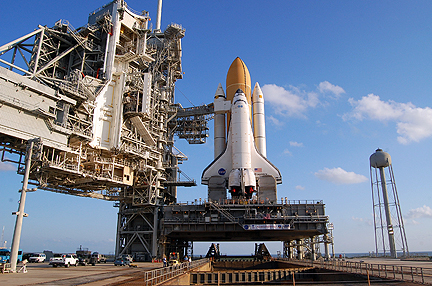
(Photos: William Harwood/CBS News) On Saturday, the Rotating Service Structure, or RSS, will be retracted again for "family day" at the Florida spaceport, when workers will be allowed to bring their families out for a launch pad drive-by and tours of other shuttle facilities.
"The first thing we're going to do is get all the systems connected up so we can start validating the systems, the boosters, the tank and the orbiter, make sure we have communications back to the firing room and so forth," said Stephanie Stilson, the engineer in charge of Discovery's ground processing.
"A little bit different for us is we're going to leave the RSS retracted all day (Tuesday) and let employees come out and take pictures, which is something new we have not done before. So that's a great opportunity for the workforce. After we do our picture taking, we'll roll the RSS back to the mate position and get busy doing all the systems checkout and testing. Family day, Saturday, we're going to retract it back. The next big event is the payload coming out on the seventh (of October)."
Discovery's crew -- commander Steven Lindsey, pilot Eric Boe, Michael Barratt, Nicole Stott and spacewalkers Timothy Kopra and Al Drew -- plans to strap in for a dress-rehearsal countdown Oct. 15. An executive-level flight readiness review to assess the shuttle's processing and to set an official launch date is scheduled to begin Oct. 19.
As of this writing, launch is targeted for 4:40 p.m. on Nov. 1. Docking with the International Space Station is expected Nov. 3 with spacewalks on tap Nov. 5 and 7. Undocking is expected around 5:40 a.m. EST on Nov. 10, with landing back at the Kennedy Space Center around 10:39 a.m. on Nov. 12.
NASA plans to follow Discovery's mission with launch of shuttle Endeavour Feb. 26 on a mission to deliver a $2 billion particle physics experiment to the space station, along with additional supplies and equipment. Program managers are hoping NASA's 2011 budget will include funding for a final flight by the shuttle Atlantis next June. The Senate version of the budget includes funding for the mission but the House version would require NASA to pay for it.
Either way, shuttle mission STS-133 will be the final flight for Discovery, NASA's third shuttle, which first took off in August 1984.
"I try not to think about it being the end for Discovery, but I do feel a bit sad, mainly because of the friends I've made on the team and the fact that in the future a lot of those friends won't still be working with me directly," Stilson told reporters late Monday. "That's the biggest part, is thinking, OK, gosh, we're not going to walk in every day and see each other and go and see Discovery and check on the vehicle and have that commonality anymore. We always will from a history perspective, but not in a day-to-day perspective. So it is a little bit heart wrenching when I think about it."
Despite the prospect of looming layoffs at the Florida spaceport, Stilson said she has no concerns about the quality of the processing team's work.
"I was concerned about that with October (layoffs) coming up and with the way things are with the workforce," she said. "But I've really just seen people stay very focused and very upbeat. Everybody handles it differently, so you see different personalities in different ways. But for the most part when I talk to folks and say, you know, what are your plans for the future, what are you doing now, how are things going, a lot of them are saying 'I'm going to stay as long as you'll let me stay here.'
"Some folks have left, they've taken other opportunities, folks I wish could have stayed. ... So we've lost some good folks, but the folks behind them are stepping up and filling in the gaps and working well together. I've been very impressed by the contractor workforce as to the way they've handled it."
She said shuttle program managers are "keeping a very close eye" on flight safety, telling the team "that if at any point in time anybody feels that we're not in a good place, we will stop and redirect and start over if we need to."
"But right now I have no fears of what we've done so far with the team we have now and I have no concerns about what we'll do in the future," she said. "If we get to a point where something is not going the way it should, we know to stop and take care of it."
Here are a few more pictures of Discovery's final planned "rollout" to the launch pad.
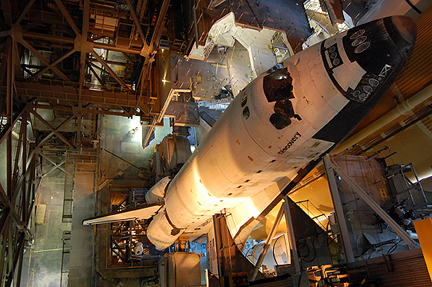
(All photos by William Harwood/CBS News)
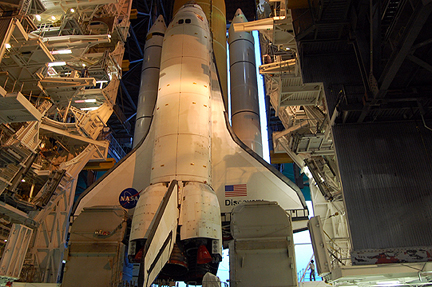
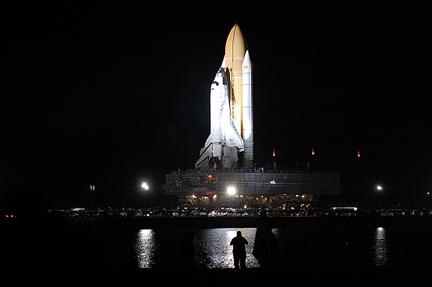
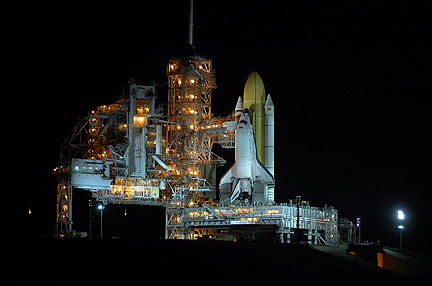
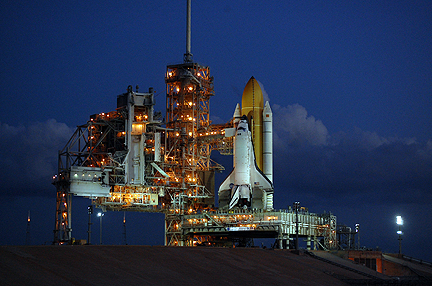
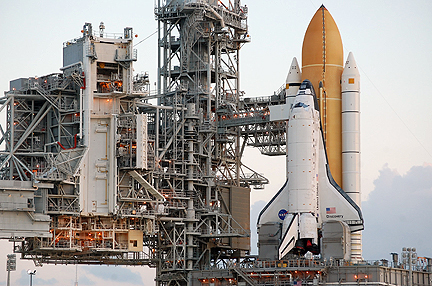
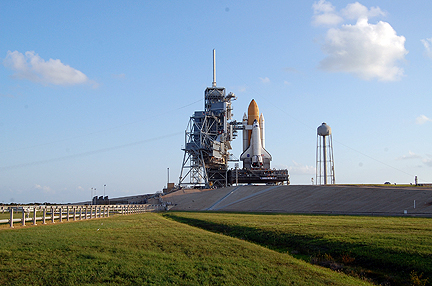
- Corrected at 11:35 PM, 9/20: Shuttle landing expected at 10:39 a.m. EST, not 11:39 a.m.
- Updated at 11:30 AM, 9/21: Shuttle reaches launch pad; adding quotes and pictures

leaves the Vehicle Assembly Building for the last time.
The shuttle Discovery, mounted atop a mobile launch platform carried by an Apollo-era crawler transporter, was hauled to the launch pad overnight Monday for work to ready the ship for blastoff Nov. 1 on its 39th and final flight.
The 3.2-mile trip from the Vehicle Assembly Building to launch complex 39A began at 7:23 p.m. EDT and was completed at 1:49 a.m. Tuesday when the mobile launch platform was reported "hard down" on its support pedestals at the oceanside pad. With good weather expected, a protective gantry will be left parked away from the vehicle to give Kennedy Space Center workers a chance to visit the pad and enjoy an unobstructed view of NASA's most experienced orbiter.


"The first thing we're going to do is get all the systems connected up so we can start validating the systems, the boosters, the tank and the orbiter, make sure we have communications back to the firing room and so forth," said Stephanie Stilson, the engineer in charge of Discovery's ground processing.
"A little bit different for us is we're going to leave the RSS retracted all day (Tuesday) and let employees come out and take pictures, which is something new we have not done before. So that's a great opportunity for the workforce. After we do our picture taking, we'll roll the RSS back to the mate position and get busy doing all the systems checkout and testing. Family day, Saturday, we're going to retract it back. The next big event is the payload coming out on the seventh (of October)."
Discovery's crew -- commander Steven Lindsey, pilot Eric Boe, Michael Barratt, Nicole Stott and spacewalkers Timothy Kopra and Al Drew -- plans to strap in for a dress-rehearsal countdown Oct. 15. An executive-level flight readiness review to assess the shuttle's processing and to set an official launch date is scheduled to begin Oct. 19.
As of this writing, launch is targeted for 4:40 p.m. on Nov. 1. Docking with the International Space Station is expected Nov. 3 with spacewalks on tap Nov. 5 and 7. Undocking is expected around 5:40 a.m. EST on Nov. 10, with landing back at the Kennedy Space Center around 10:39 a.m. on Nov. 12.
NASA plans to follow Discovery's mission with launch of shuttle Endeavour Feb. 26 on a mission to deliver a $2 billion particle physics experiment to the space station, along with additional supplies and equipment. Program managers are hoping NASA's 2011 budget will include funding for a final flight by the shuttle Atlantis next June. The Senate version of the budget includes funding for the mission but the House version would require NASA to pay for it.
Either way, shuttle mission STS-133 will be the final flight for Discovery, NASA's third shuttle, which first took off in August 1984.
"I try not to think about it being the end for Discovery, but I do feel a bit sad, mainly because of the friends I've made on the team and the fact that in the future a lot of those friends won't still be working with me directly," Stilson told reporters late Monday. "That's the biggest part, is thinking, OK, gosh, we're not going to walk in every day and see each other and go and see Discovery and check on the vehicle and have that commonality anymore. We always will from a history perspective, but not in a day-to-day perspective. So it is a little bit heart wrenching when I think about it."
Despite the prospect of looming layoffs at the Florida spaceport, Stilson said she has no concerns about the quality of the processing team's work.
"I was concerned about that with October (layoffs) coming up and with the way things are with the workforce," she said. "But I've really just seen people stay very focused and very upbeat. Everybody handles it differently, so you see different personalities in different ways. But for the most part when I talk to folks and say, you know, what are your plans for the future, what are you doing now, how are things going, a lot of them are saying 'I'm going to stay as long as you'll let me stay here.'
"Some folks have left, they've taken other opportunities, folks I wish could have stayed. ... So we've lost some good folks, but the folks behind them are stepping up and filling in the gaps and working well together. I've been very impressed by the contractor workforce as to the way they've handled it."
She said shuttle program managers are "keeping a very close eye" on flight safety, telling the team "that if at any point in time anybody feels that we're not in a good place, we will stop and redirect and start over if we need to."
"But right now I have no fears of what we've done so far with the team we have now and I have no concerns about what we'll do in the future," she said. "If we get to a point where something is not going the way it should, we know to stop and take care of it."
Here are a few more pictures of Discovery's final planned "rollout" to the launch pad.






